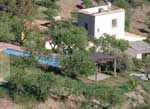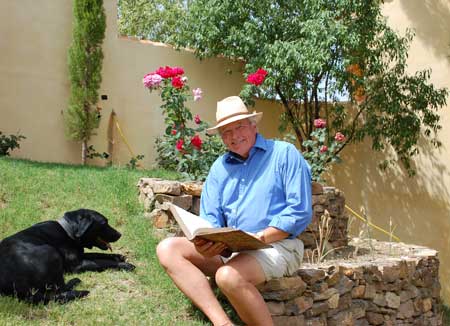Creating my idyll in Andalucía
Five years ago, Simon Munro Kerr abandoned the bitter winters of Jura in the Inner Hebrides and took on a tumbledown farm in the hills of Andalucía


The busy Autovía del Mediterráneo, that snakes along the south coast of Spain, fractures between Adra and La Herradura.
This stretch of main road is uncharted territory as far as tourists are concerned; few will venture off the route and into the ridge of hills, dotted with olive groves and vineyards. But a glance at the map was enough to convince Simon Munro Kerr that this forgotten piece of Andalucía could provide the ‘splendid isolation’ he was looking for. ‘I had decided I wanted to live in the hills between the coast and the Sierra Nevada, so I worked the area with binoculars looking for abandoned properties,’ he says. ‘Most weren’t available, but then I found Cortijo de la Jarilla, a ruin in a hidden valley, and it was exactly what I wanted.’ Nearly five years later, having transformed the tumbledown stone settlement into a productive working farm,
Simon is reluctantly selling up. ‘It’s a magical place and I use that word very carefully. And now it looks as it would have done 100 years ago—if it had been slightly grander.’
Simon, who had a walk-on part in Dr No, first came to Spain in 1963 to make a film. He married a Spanish woman and spent several years living near Madrid. But, in 2003, when he stumbled across La Jarilla while hunting for ruins with his daughter, he had been living on Jura, off the west coast of Scotland, for more than a decade.
‘The winters in Scotland got monotonous and depressing, and my spirits were not at their highest. La Jarilla was more or less the same environment, but instead of being 50 yards from the sea, it was 3,000ft above it. Land and space are very important— it was Mark Twain who said “buy land—they’re not making it any more”.’

Simon Munro Kerr at La Jarilla
The purchase was ambitious, considering the buildings had been derelict for 35 years and Simon’s Spanish was by no means fluent. ‘It had been owned by a doctor who bought it as an investment and all he’d done there was plant 2,000 almond trees. The most important words I learnt were ayúdame por favor. But there’s an amazing bush telegraph out here—the local people were marvellous.’ Simon rented a house in a nearby village while he sketched out what he wanted to do to the farm, and tried to find local people to help him do it. ‘I knew I needed to find a godfather figure to lead me by the hand to the local ways.’
Sign up for the Country Life Newsletter
Exquisite houses, the beauty of Nature, and how to get the most from your life, straight to your inbox.
This wasn’t easy, considering La Jarilla’s remote location. ‘My immediate neighbours are the wild boar and partridge; the nearest member of my own race, the only house I can see from mine, is half a mile as the crow f lies and three miles by road.’ It took him several months to find anyone that was as enthusiastic about La Jarilla as he was. Eventually, professional plans were drawn up, based on the original footprint of the building, and work began.
However, he didn’t expect to still be working on it four years later. ‘I’ve worked harder than I ever did when I was half my age. From 8am until 8pm, six days a week, we worked on the house, spending Saturdays scouring for old windows, doors and rajas.’ More than 300 lorry loads of stone were hauled through the hills to La Jarilla from ruins across Andalucía, as well as 340 chestnut beams and thousands of terracotta tiles. ‘All the materials were sourced locally.’
In the main house, the sitting room is of church-like proportions, with huge windows and exposed beams. The floors are solid oak and the staircase is ‘a grand affair’ with wrought-iron railings. There is a gallery landing, vast bedroom, dressing room and bathroom. ‘There’s only one bedroom in the main house—it’s rather American in that respect.’ Guests stay in the three spacious cottages with terracotta floors, in the former barns and stables, and there’s a tennis court, several terraces and a swimming pool.
Needless to say, Simon is rarely without friends and family visiting from Britain. ‘It’s the air and the light that make it so magical—you can see Africa from here, there’s no pollution. I’ve had people here who can’t sleep on the first night because it’s too quiet. But the coast is only 25 minutes away.’
Last month, he had 23 people staying in the cottages; amusing anecdotes from their stay are scribbled in the visitor’s book. ‘But when I’m here on my own, I don’t rattle around. Last night, I took my labrador out and looked up at the sky—it goes on forever and ever, and it’s much better than watching television.’
Cortijo de la Jarilla is on the market for €1.5 million (00 34 680 915 888; www.lajarilla.net)
Country Life is unlike any other magazine: the only glossy weekly on the newsstand and the only magazine that has been guest-edited by HRH The King not once, but twice. It is a celebration of modern rural life and all its diverse joys and pleasures — that was first published in Queen Victoria's Diamond Jubilee year. Our eclectic mixture of witty and informative content — from the most up-to-date property news and commentary and a coveted glimpse inside some of the UK's best houses and gardens, to gardening, the arts and interior design, written by experts in their field — still cannot be found in print or online, anywhere else.
-
 380 acres and 90 bedrooms on the £25m private island being sold by one of Britain's top music producers
380 acres and 90 bedrooms on the £25m private island being sold by one of Britain's top music producersStormzy, Rihanna and the Rolling Stones are just a part of the story at Osea Island, a dot on the map in the seas off Essex.
By Lotte Brundle Published
-
 'A delicious chance to step back in time and bask in the best of Britain': An insider's guide to The Season
'A delicious chance to step back in time and bask in the best of Britain': An insider's guide to The SeasonHere's how to navigate this summer's top events in style, from those who know best.
By Madeleine Silver Published
